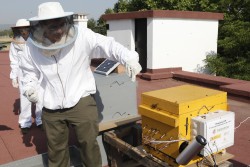 This morning, the University of Cordoba has installed its first digital beehive thanks to the research project developed by New Technology Based Firm (NTBF) Apoidea financed by the Environment Agency and the City Council of Cordoba, and with the scientific collaboration of the ‘IUT de Bourges’ from the University of Orleans (France).
This morning, the University of Cordoba has installed its first digital beehive thanks to the research project developed by New Technology Based Firm (NTBF) Apoidea financed by the Environment Agency and the City Council of Cordoba, and with the scientific collaboration of the ‘IUT de Bourges’ from the University of Orleans (France).
The installation of the beehive will allow for the online monitoring of the Apis Mellifera to study in real time the repercussions of the environmental quality of the city of Cordoba on the life of bees, a species used as an environmental biomarker for years. The new system will allow for the control of the activity of the twenty-five to thirty thousand bees who inhabit the hive in the summer and whose numbers in winter reduce to just five thousand.
As the coordinator of the project José Antonio Ruiz explains, with nineteen sensors and a webcam, the behaviour of the colony and the evolution of their biological cycle will be available to view online, along with the collection of details about the amount their colony forages, their life span (both natural and that produced by various contaminants), the weight of the colony, the temperature of the nest and meteorological details of the environment.
The new digital beehive has been installed in the Andalusian Beekeeping Reference Centre on the Rabanales campus, a research centre that dedicates itself to the study of Colony Collapse Disorder (CCD) that has been related to nutrition, insecticides and infectious diseases, and that the researchers at the University of Cordoba are analysing thanks to a project financed by the ‘National Beekeeping Plan.’
The installation of the new hive by Apoidea will allow for as many advances in CCD as in the evolution and repercussions of climate change, while at the same time it will collect direct information about pollution in the city of Cordoba.
To install the new innovative device, more than one hundred and sixty metres of cable have been used, and collaboration from Cordoba University’s Technical and Computer Science departments have been necessary.
Jueves, 22 Diciembre 2016 16:58
The University of Cordoba installs the first digital beehive to control the activity of bees in real
Escrito porThe device will allow for advances in the study of Colony Collapse Disorder (CCD) in beehives, which is key in climate change analysis.
Publicado en
Ciencias de la naturaleza

